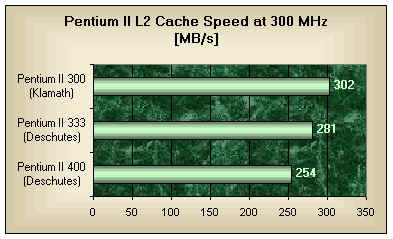Intel's Slot 1 CPUs Uncovered
From The Intel Pentium II 350/400 Data Sheet
As you can see there's a serious difference between 333 and 350 MHz Pentium II CPUs and its brothers at 400 MHz. The 400 MHz version has got a different tag RAM chip as well as faster L2 cache modules. 5 ns instead of 5.5 ns seems to sound almost the same, but we shouldn't forget that 5 ns is about 10% faster than 5.5 ns, which comes close to the increase in core clock or L2 cache frequency respectively of 14% from 350 to 400 MHz. This is not the only difference, the 5 ns L2 cache modules are cooled whilst the 5.5 ns modules in the Pentium 333 and 350 aren't. This is done via a different back plate of the Pentium II 400 single edge cartridge (SEC), which has two special notches that fit directly on the two modules, as you can see below. The third difference is the timing of the L2 cache. As already said above, the L2 cache timing of the Pentium II 233-300 MHz CPUs is faster than the L2 cache timing of the Pentium II 333. Now the timing of the 5 ns L2 cache in the Pentium II 400 is even slower than in the 333 and 350 models. This is something that should be considered by hardware testers that want to use the easily overclockable Pentium II 333 as test CPU for 400 MHz testing, because the benchmark results scored by this overclocked CPU are higher than what you would get with a real 400 MHz Pentium II.
The latest version of Andreas Stiller's good old low level benchmark program 'ctcm.exe' (published by c't-Magazine) shows nicely the difference in L2 cache speed. Here are the results of the L2 cache speed at 300 MHz core clock, ran on a Pentium II 300, a Pentium II 333 and a Pentium II 400:
Running each of these CPUs in an application type benchmark like e.g. Winstone shows that at 300 MHz, the Pentium II 400 is scoring considerably less than a Pentium II 300 or 333.
This will also be a pretty nice way of finding out if a 333 or 350 MHz CPU was counterfeit to a 400 MHz model. If ctcm shows 280 MB/s for the L2 cache speed, you can be 100% sure that you've bought a counterfeit CPU, opening the CPU and finding 5.5 ns cache will finally prove it.
Overclocking of Pentium II with Deschutes CPUs will in most cases also require the increase of the front side bus, since the higher multipliers will most likely be disabled by Intel. The Pentium II 333 has a multiplier up to 5x built in, so that you can theoretically reach pretty high clock rates, as long as a BX motherboard will let you run this CPU at 100 MHz FSB or even more. Motherboards that detect the FSB clock automatically can only be fooled if you should be courageous enough and change the above mentioned resistors on your CPU PCB. I recommend you rather go for a motherboard that let's you choose 100 MHz FSB or more regardless what CPU is in there. Overclocking is pretty dangerous when you look at the system stability point of view. Intel has got a good reason for using cooled 5 ns L2 cache modules on their 400 MHz part. The CPU core will in most cases do the higher clock rate just fine, however the L2 cache running at half of this higher clock speed will most likely cause erratic behaviour and can easily be the reason for system crashes. I consider everyone as really crazy, who runs his business software on a system with a highly overclocked Deschutes CPU. Nevertheless, keeping in mind that you can run into system crashes at any time, overclocking works pretty well in the following cases:
- Pentium II 333 to 350/100, careful at 400/100 (requires motherboard that let's you choose 100 MHz FSB)
- Pentium II 350 to 392/112, possible L2 cache issue, possible PC100 SDRAM issue at 112 MHz
- Pentium II 400 to 448/112, possible L2 cache issue, possible PC100 SDRAM issue at 112 MHz
People that overclock to more than that either post this to make themselves look important without using the system at this speed or they must be considered as a bit crazy. Reaching higher speeds safely only works with special 7 ns SDRAM modules and a Kryotech cooling system as shown by Intel at CeBIT 98, when they presented the 700 MHz Pentium II system.
Get Tom's Hardware's best news and in-depth reviews, straight to your inbox.
Current page: From The Intel Pentium II 350/400 Data Sheet
Prev Page Intel Pentium II 233 - 300 CPUs, Core Codename Klamath Next Page The Common Core Voltage Of The Deschutes Core Is 2 V